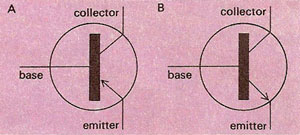transistor

Geometric symbols for transistors (A) with n-type base; (B) with p-type base.
A transistor is an electronic device made of semiconductor material that can amplify electrical signals. The material, such as silicon or germanium, is "doped" with minute amounts of phosphorus, arsenic, or antimony to produce n-type material, in which current is carried by negative charges, electrons; or with aluminum, gallium, indium to give a p-type material. Joining together a piece of each produces a diode. Sandwiching one type between two of the other produces a transistor. These can thus be of two kinds: a p-n-p or n-p-n transistor. The middle region is known as the base, one of the side regions as the emitter and the other as the collector. In an n-p-n transistor, the signal to be amplified is fed across the collector, maintained at a constant voltage with respect to the base. The amplified signal comes out across the base and the emitter.
Transistors were first developed in 1948 by John Bardeen, Walter Brattain, and William Shockley, making possible many advances in technology, especially in computers, portable radios and televisions, satellites, industrial control systems, and navigation.


